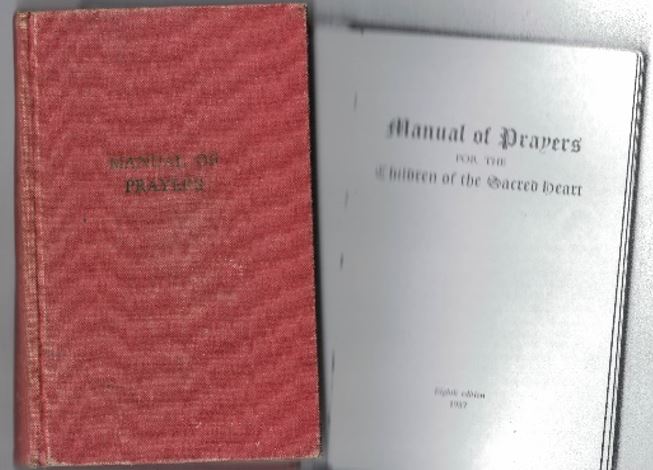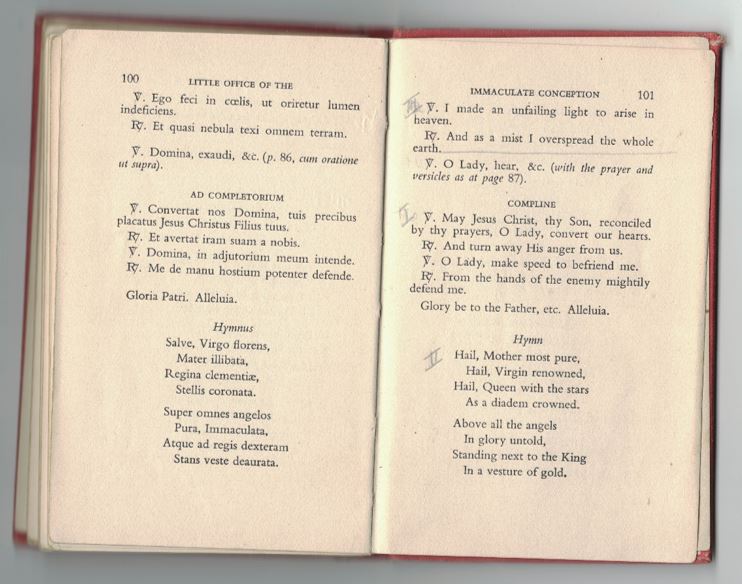1950's & 1960s
1951-1957 Anne Booth (nee Deering)
In memory of Ann Booth who passed away on 20 November 2017. Ann wrote this for Eileen Foster as part of her book about the school.
When I heard I was to go to the Sacred Heart Convent in 1951, at the age of 11, I cried. After attending an ordinary primary school, I was suddenly separated from my friends. No one in our family had gone to the Sacred Heart before. My mother was so amazed and delighted, I couldn't tell her the real reason for my tears, so I said I had walked into a door.
On the first morning at Sacred Heart, my mother accompanied me, and we sat on the stone seats in the cloister. Like everyone else I was wearing white gloves. I only remember one other girl from that first day and that was because she had the loveliest gold ringlets I'd ever seen. Her name was Kathleen Schrader (now Kathleen Ames).
I was put into Upper III, in a classroom on the first floor. We used to stand on the pipes in this corridor to look out of the window to watch the ballet dancers practising in the building next door.
In the classroom we sat in four lines, and I was in the line by the wall, designated as Group 4, known as the Immaculate Conception, colour blue. The first row by the window, Group 1 was Mater Admirabalis, colour red. Group 2, the Sacred Heart was yellow and Group 3, St Madeleine Sophie, was green.
I settled happily into the school routine and could play the piano, and was chosen to play the hymn at morning Assembly -terrifying! I played the violin in the orchestra and in one music festival managed to finish a full two bars ahead of everyone else.
During my final year I took advanced level music coached by Mr Buckley. Mother Hammond suggested that I should go on to Trinity College of Music, and it is because of the encouragement and help I received there that music has been so important in my life. I am still teaching and accompanying!
Other memories include early morning Mass with a large contingent of nuns filling the choir stalls in the chapel; wearing our veils on First Fridays; saying the rosary on our knees in the classroom led by Mother Mackin, zipping through the beads at break-neck speed and special feast days when we processed round the cloisters wearing veils and carrying lighted candles.
There was a weekly meeting of the whole Division where we were each given a card denoting our behaviour. The 'options' were - Very Good, Good, Fair, Unsatisfactory. The ultimate disgrace was to receive no card at all! The whole performance taught us self-discipline: sitting up straight without fidgeting was a lesson in itself!
There were lots of wonderful teachers. Miss Guessard was so inspiring and generous with her time; Miss Bonser, Games Mistress and Miss Vieyra for maths who had the most wonderful fudge for the Summer Fete.
I am very fortunate indeed that it was my lot to go to the best school in Hammersmith.
1952-1959 Bonita Williams (now Bonita Targett)
I was at the Sacred Heart in Hammersmith from1952-1959. It was, always my mother's dearest wish that I should attend Hammersmith. She, herself, had been to The Sacred Heart in Fenham, and nothing less was good enough for her daughter. I had, in fact, when I passed the Scholarship Exam as it was then called, been offered a place at Jesus and Mary Convent in Willesden, but my mother took on the Middlesex County Council (MCC) Education Dept. to persuade them to change this to an offer of a place at Hammersmith. My mother, who attended the Society of Jesus and Mary meetings once a month at Hammersmith, was aided and abetted in this by Mother Hammond, who she knew well. She knew most of the nuns, Sr. Hopper, Mother Makin, Mother Deane, whom she'd been at school with in Fenham, Mother Davidson, Rev Mother McKeon.
That particular year the London Country Council (LCC) had only been funding one class, but when Mother Hammond persuaded them to allow another class of 30 to attend, she 'tipped my mother the wink' and the onslaught with MCC started. The big problem was that MCC were required to pay my school fees to LCC for 'an out County Scholarship'. Needless to say, they were not very happy about this. But, in the end, gave in.
It was then up to Daniel Neal's in Kensington for the royal blue serge dress with the detachable cream collar. For an eleven-year-old, I had a horrendous journey every day from South Ruislip on the bus up to Ruislip to catch the Piccadilly Line to Hammersmith. I think I spent all my school years absolutely exhausted, having caught the bus at 07.25 and not getting home again in the evening until 17.30. We didn't leave school in those days until 16.00. In the winter I left home in the dark, and arrived back long after darkness had fallen. Then hours of homework. This was the '50's, and we used to pray for smog, and to be sent home early.
I was put in to Upper 111 Alpha. Sr. Denise Calder and Pauline Collins were also in my class. Mother Morris was our form teacher. I always said that Mother Morris invented holistic education. She cared about every aspect of our education and development, always checking our cream collars were clean for 'Notes' on Friday afternoons, etc. She trained us to curtsey to Reverend Mother and to walk out of chapel in two lines, each keeping in place as we made the lines curve out the door on the side into the Cloisters.
Mother Morris took a dim view of my handwriting from my primary school and, although very careful and neat, she said it sloped backwards. So, as well as the journey and homework, I had to do an extra page of handwriting practice every evening to change my backhand, with loops, to Italian Cursive writing. But it paid off. I became the best at handwriting on the class, and have always claimed that I got every job I have ever applied for due to my beautiful handwriting.
I met Mother Morris many times before she died. Although, by then fully grown up, and urged to call her 'Pat', I could never bring my self to do so. She was, always 'Mother Morris' to me.
Looking at school photographs, I am struck by the students blazers still being so similar to that I wore all those years ago, except our had 'Strong and True' emblazoned under the SH. Very embarrassing!!!
The King and I opened in London in October 1953 and Virginia Tiverton in Upper 111A was the juvenile lead. She was the only non-white child in the whole school (Burmese). This was in the '50s when so many people from the Caribbean were train guards or bus ticket collectors. We were very jealous of Virginia as she had every Wednesday afternoon off for the matinée. She was very clever (everyone was, apart from me, but I had the best handwriting!), but she had her own chaperone and tutor at each evening performance.
Dympna Connolly was the first Sacred Heart girl to get to Oxford. This was in 1959. Talk about a blue stocking!!
1956-1963 Stephanie Romaine (now Sister Stephanie Romaine RSCJ)
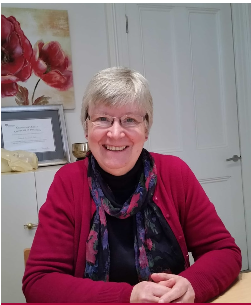 |
Certain traditions were kept which were common to all Sacred Heart Schools. These were:
|
Each year, the school had a Retreat which meant coming in on a Sunday. The highlight of the day was sausage and mash provided by the nuns. Also, we were allowed in the community side of the house which was usually out of bounds. We were very aware of the enclosure, and as a result were always trying to peep through doors and keyholes to see what was there!
The school offered a Day of Recollection for local priests once a month and were expected to make ourselves scarce, so as (we thought!) not to be a source of temptation.
At this time the staff included Mother Davidson, Mistress General; Mother Pat Morris, Mistress of Discipline; Mother Clare Deagle (in charge of the third division); Mother Josephine Heywood, (3rd Year Class mistress, RE and Drama); Mother Margaret Adam (history and RE); Mother Monica Ward tau (English and played the organ); Miss Eileen Bonser (PE); Miss Margaret Wilson (biology); Miss Marjories Guessard (French); Miss Billsborrow (Maths); Mr Ted Buckley (music).
Older members of the community could often be found sitting at the lodge, and we often had chats with them and told them our woes.
In the sixth form we sometimes stayed the night at school, possibly during Holy Week, so we could take part in the Night Adoration in the chapel. The Community Mass was every day at 7.30am and quite a group of people of all ages used to come for it. We had our breakfast after Mass and real coffee, a highlight, brewed specially by Mother Heywood.
1959 -1967 Rosemary Callingham
I attended Sacred Heart from 1959 to 1967, and have many memories of my time there. I have tried to group these memories under themes or occasions.
Uniform
The uniform, which was purchased from Daniel Neal’s in Kensington, was a French navy tunic with a heart shaped bib, and a pale coffee coloured shirt. We wore black lace up shoes for outside and brown, buttoned Mary Jane’s indoors. In summer, we wore blue and white striped shirt dresses. We had blue blazers, very similar to those of today, and the badge is also similar. The school motto was Strong and True.
In Upper 3 (today’s Year 7) we had to wear blue gingham bib aprons all day except for Religious Education (RE). By Lower 4 we graduated to a blue tabard-style apron but still were required to wear this all day. In Upper 4 we still had the tabards, but were only required to wear them for lunch and art. Lower 5 saw us graduate to not needing aprons at all, and in Upper 5 we graduated to wearing a blue tie and were also allowed to wear stockings rather than socks. This last requirement ensured that there was always a row of girls from lower years in the subway by which we crossed Hammersmith Broadway changing their stockings for socks (this was well before tights!)
Uniform wearing was heavily enforced. We had to wear gloves (brown in winter, white in summer) and berets (straw boaters were optional in summer). We had blue gabardine coats for winter and a woollen scarf, striped pale and dark blue with tassels. It was a fashion for girls in sports teams to swap a tassel with the opposing team, so the scarves became quite colourful.
For sports, we had light blue collared t-shirts (Aertex or similar from memory) and divided skirts in navy. Again, we had black plimsolls for outdoor sports and brown for indoors.
Academic Life
We started school at 8.40am (as far as I remember). I came from Ealing (out of area), so my journey to school started around 7.30am with either a bus ride or walk (about 25 minutes) to Ealing Broadway station where I caught a District line train to Hammersmith. We had a short home group period and then started lessons. Each period was 40 minutes. There was a short (perhaps 15 minutes) break mid-morning. During that time we were able to get 1/3 of a pint of milk (provided to all school children). When I started, this still came in small glass bottles, but it changed to tetra-packs and I remember representatives of the company coming to show us how to use these. The nuns used to sell us biscuits – 3 for a penny for plain biscuits or two for a penny if they were “squashed fly” biscuits with currants in them. The biscuits came in large tins.
Every girl stayed for lunch. The lunch period was also 40 minutes and there were three sittings in two dining rooms off the cloisters. The senior prefect present (or the supervising nun in the junior years) said Grace, and at specific times of the year, we also had particular devotions.
The physics lab was also off the cloisters and next to the kitchen. It was warm and quite dark, and it was a struggle to stay awake in the afternoon classes. We were taught Physics by Mrs Carter, who told us of seeing J.J. Thompson at Cambridge. He was a figure in history from our perspective, who had died some 20 years before we got to Sacred Heart. [J J Thompson was a physicist credited with the discovery of the electron].
We learned Biology (Miss Wilson) and Chemistry (various teachers, most of whose names I have forgotten) as well as physics. It was not lumped into “science”. Mathematics was taught by Mrs Bilsborrow and Mrs Mackintosh.
Latin was taught by Miss Hamilton. I have very vivid memories of her describing what the Romans must have been confronted by when they invaded – little men, painted blue with woad, yelling and jumping around. We also did French, English – language and literature – history and geography. Geography was taught by Mother Patterson, who, I think, went to Australia; History was Mother Adam. There was also art and sewing – I never did cooking which was optional in Lower 4. Notably, especially for the period, there was no typing and shorthand. PE was Miss Bonser who was legendary! We also had Miss Knight and Miss Smith, who was a world record holder in athletics. We played netball and hockey (at Roehampton) competitively in winter and tennis in summer. I also remember playing rounders.
Music was mainly singing, taught by Mr Buckley – the only male teacher. We gave him a very hard time, and for some period of time our music lessons were patrolled by one of the nuns and all our chairs were spread out. We must have improved our behaviour because when I was in the Sixth Form we put on a production of Dido and Aeneas by Purcell. I also remember elocution with Mother Francis. Oral English was strong, and we took this as part of our O-Levels. I vividly remember having to talk for one minute on ‘deck chairs’ and having to prepare and deliver a 5-minute presentation, which I did on the Royal Ballet – one of my interests at the time.
Some girls were encouraged to take O-Levels early. I took three exams one year early and another in January of the main O-Level year (Upper 5). Additional O-Levels were possible during sixth form. The program was intense, and the school set very high expectations.
Religious Education
RE was a strong focus of course. We had to bring in some handy work (knitting, embroidery) to do while we listened to meditations or readings. I can still picture my piece of ink-stained embroidery. Every year group had a weekend retreat, usually led by a Jesuit priest. These were times of silence – quite a challenge for teenage girls. The sisters catered for lunch which was always sausages and mash, and some kind of trifle with hard fruit drops on it. I distinctly remember seeing Alec Guinness and Jack Hawkins in The Prisoner, and the retreat leader analysing why the Cardinal (Guinness) finally succumbed to the pressure because he was “too humble”.
|
We could also, if we chose, attend Mass at 7.30 every morning in the Chapel, after which we would be given breakfast. I used to do this fairly frequently when I was older. There were processions around the cloisters for special feast days including the Immaculate Conception – always marked with white lilies that must have cost a fortune in December. We had to wear white veils. Like the uniforms these were graded in quality. The lower school had the oldest, white cotton veils while the sixth form had lovely fluffy white nylon veils. We carried lighted candles and there was the occasional accident when a veil caught alight! I still have the missal that was required (on the book list) when I started in 1960, together with many of the holy pictures that I collected over the years. The Mass was still in Latin although there was a translation and many of the prayers and readings are in English. Vatican II happened during my time at Sacred Heart, bringing big changes, including to the nuns’ habits. There was also a small Book of Prayers that contains the various prayers that were recited at special feasts. The Immaculate Conception office is marked up for 3 or 4 speakers (rather pretentiously using Roman numerals!) The verses still resonate with me. |
|
Despite the strong Catholic focus, RE was not narrow. We read the Screwtape Letters by C.S. Lewis. We looked at creation myths in relation to Genesis. We discussed proofs of the existence of God. Perhaps surprisingly for the times, I felt we were encouraged to think and question.
Discipline
The school was broken into three sections: Lower (Upper 3 and Lower 4), Middle (Upper 4 and Lower 5) and Upper (Upper 5 and Sixth Form). When I started Mother Deagle was in charge of Lower school.
Discipline was never physical – no hitting or standing in the corner that I remember. Each week we had “Notes”. This was a ritual in which every girl was presented to the Reverend Mother to receive her Note for the week – Very Good, Good, Fair or Unsatisfactory. The Notes were small pieces of card about the size of a (then) bus ticket. We had to line up following a specific routine and, as our names were called, to move to a spot in front of Reverend Mother, curtsey, take our note and then move away, depositing the note in a collection bowl. It was regarded as very poor to receive “fair”, and the few girls who got unsatisfactory were not even allowed to sit with their class or receive a note. I think the notes earned house points. There were three houses, Raphael, Gabriel and Michael – I was in St Michael House. I don’t remember any great rivalry between the houses, although we did have a sports day once a year at Rockhampton.
We had to curtsey to the Head Mistress (Mother Davidson in my time). I remember that she would stand on a landing halfway up the stairs so that if you were late to a lesson, you had to slow down, curtsey and proceed slowly up the stairs until you were out of sight.
Other Events
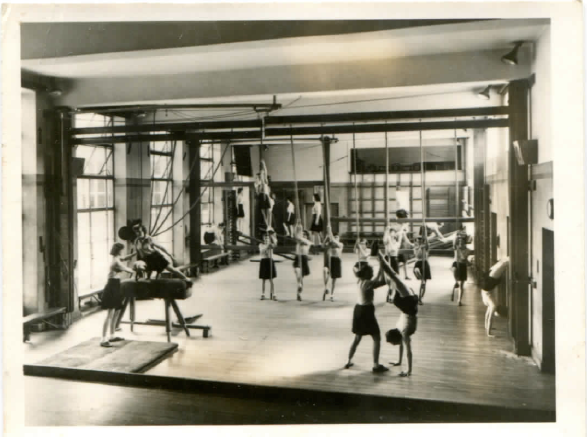 |
At the end of each year, we had to present an oral display as a home group class. The subject depended on what was taught by the home group teacher. One year I remember doing art, based on pictures at an exhibition. Another year we did PE – a gym display. I found the picture left on the Sacred Heart website. I remember the photo being taken! I am the girl doing a handstand, front right, supported (I think) by Sally Blunt. Another keenly anticipated event was the leavers’ year concert/show. The final year girls finished their exams early and they were expected to write, produce, and perform some kind of concert. This usually took the form of a variety show and the “in jokes” and very amateur production was wildly applauded. It was one time when (almost) anything was accepted. |
At the end of the year was prize giving. Every class was rank ordered in every subject. We could usually choose our book prizes from a pool – I still have some of these and the book plates that went with them, showing the door from the garden into the main building. One that I have tells the story of Philippine Duchesne (in French), and how she brought the Order to America and Canada.
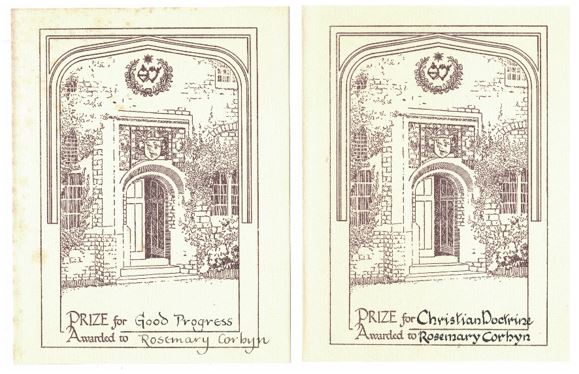 |
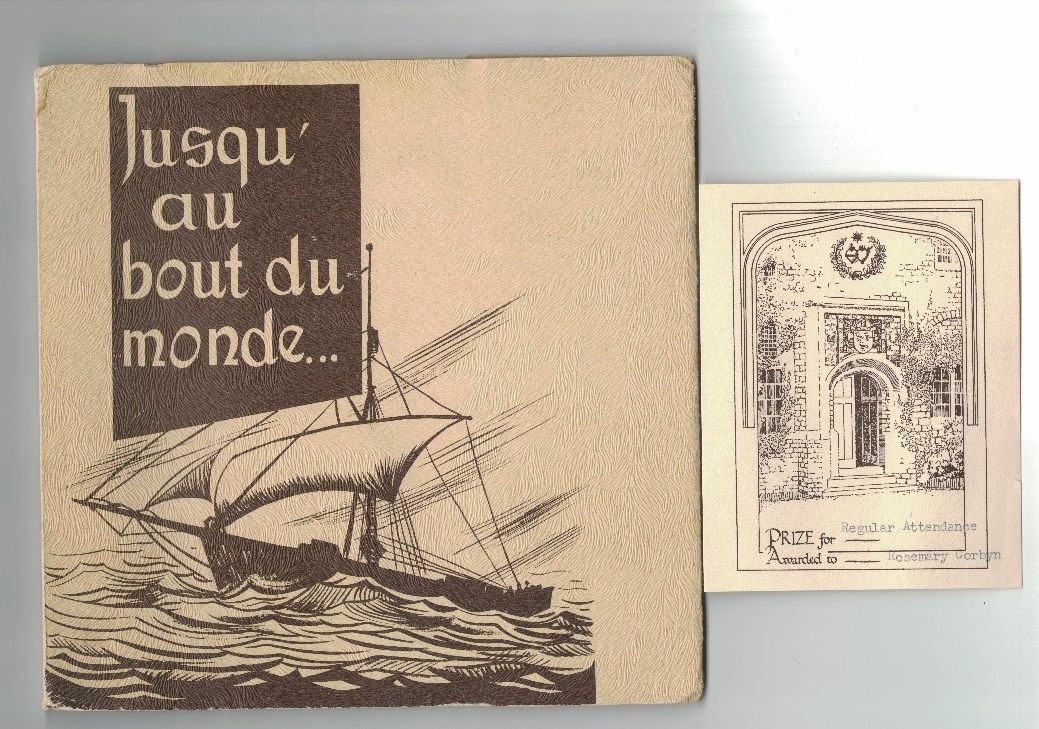 |
Reports were handwritten and sent home twice a year in December and at the end of the year. This is typical of the comments and information – very summative.
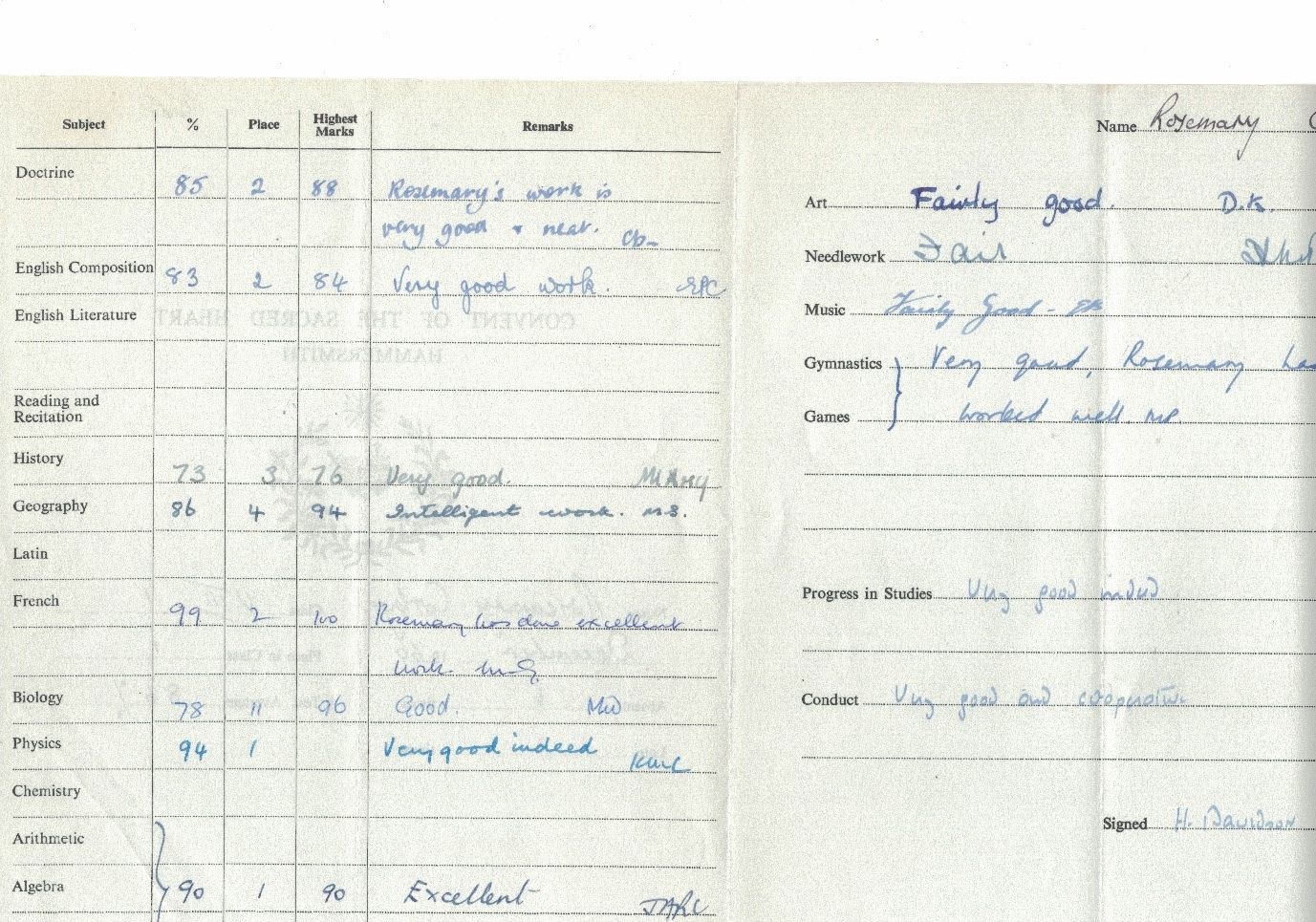
I was once asked what I really liked about school. For me it was undoubtedly the learning. I was taught how to learn, how to build an argument and the value of a broad education. Sacred Heart, Hammersmith gave me that, and it has stood me in good stead.
